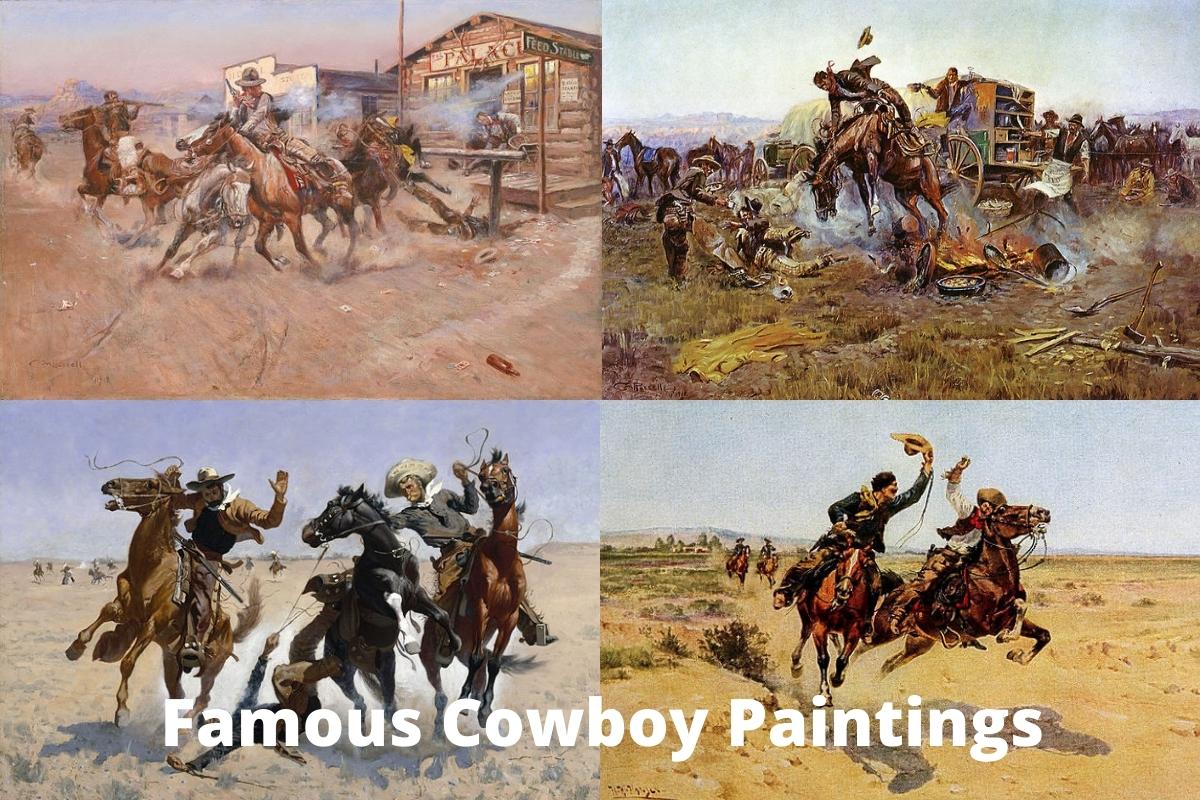The American West is one of the most iconic and distinct time periods in history that sparked its own unique genre of artwork.
For many decades, painters have portrayed scenes from the old Wild West era when Native Americans still held a sizable portion of most land east of the Mississippi River and cattle were driven many hundreds of miles across the prairie and open grasslands east of the Rocky Mountains.
Cowboys have become a legendary part of American culture that has also fascinated people all across the world from continents like Europe and Asia.
The life of a cowboy was often filled with hardships and obstacles that had to be endured and this type of rough lifestyle is something that artists have sought to capture through paintings for many years.
In this article, we’ll explore 10 of the most famous cowboy paintings and discuss the artist behind the works, as well as the purpose and motives they had in painting such works.
Famous Cowboy Paintings
1. The Fall of the Cowboy – Frederic Remington
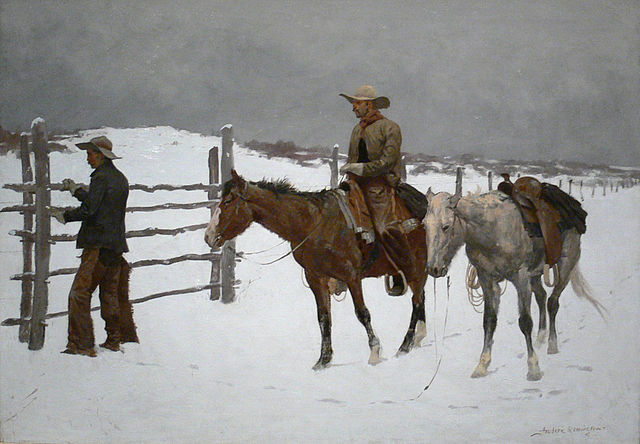
Frederic Remington is one of the most famous artists to have focused much of his career on creating depictions of the American Old West, specifically the 19th century.
Born in New York during the start of the Civil War, Remington’s father was a colonel in the Union Army. The artist showed particular inclination for producing drawings and sketchings of soldiers and cowboys at a very early age.
His 1895 painting titled The Fall of the Cowboy was meant to document the end of the cowboy way of life, which Remington viewed as a tragic loss of a major part of the country’s culture.
The snowy winter was intended to symbolize the winter of the American West, which was swiftly being rendered pointless in the face of industrial development. In the painting, two cowboys are stopped at a fence and one is opening a gate to allow them to pass through.
The fence represents the barrier that the cowboy lifestyle had reached and the freedom they once enjoyed would no longer be possible with the ever-present development of cities and towns across the West.
2. Camp Cook’s Troubles – Charles Marion Russell
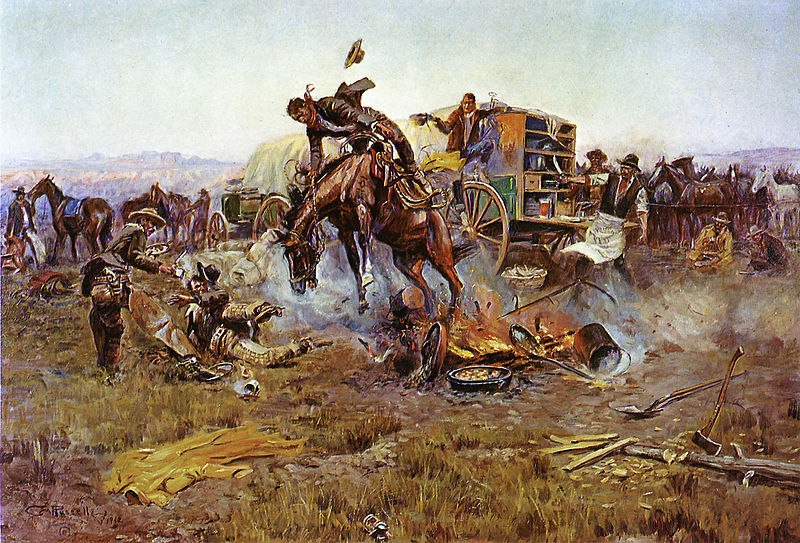
Charles Marion Russell is famous for his depictions of characters from the American West that included cowboys, Native Americans and others. One of Russell’s paintings is widely recognized as a famous cowboy painting that symbolizes life and difficulties of life on the trail for cowboys and those that were associated with them.
The painting is titled Camp Cook’s Troubles and was completed in 1912, although he created other works that were very similar. The painting depicts a bronco bucking violently in the middle of a cowboy encampment.
A cowboy is clinging on to the saddle in a futile effort to tame the beast while others are knocked to the ground and scrambling to escape the mayhem caused by the bronc.
The cook is seen wielding a long knife, which he has trained on the bronc while the viewer can see much of the cook’s efforts have gone to waste thanks to the horse’s wild antics.
3. Texas Cowboy– Stanley L. Wood
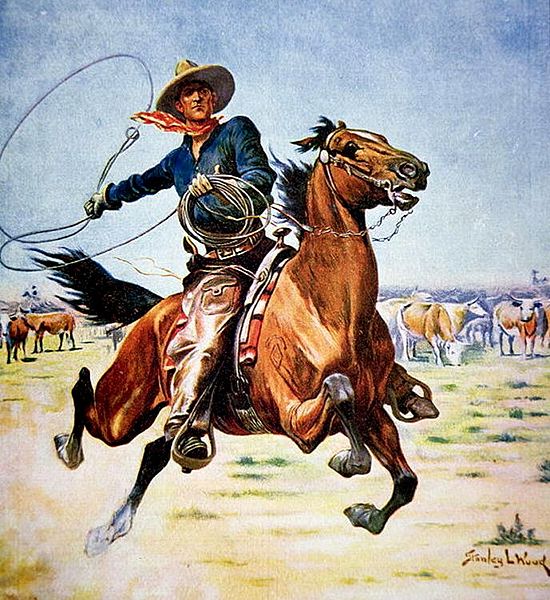
Stanley L. Wood was a distinguished illustrator that focused much of his career on producing works that pertained to the American West and the classic representation of the cowboy.
Born in Wales, his family moved to Kansas when he was only 6 years old after his father was entangled in a scheme that drained much of the family’s finances and forced them to stake out a life in the fledgling territory.
Wood’s family moved back to England after threats from the same band of Native Americans and his adult life would be forever altered by his years in the West.
Later in his career as an artist, he created a work simply titled Texas Cowboy. This painting depicts a cowboy riding on a fast-moving horse while holding a lasso and rope.
The cowboy’s gaze is fixed on what can only be a steer that he is preparing to lasso and tie. The painting features the rustic theme and colors that were so often characteristic of Wood’s works.
4. The Horse Rustler – William Herbert Dunton
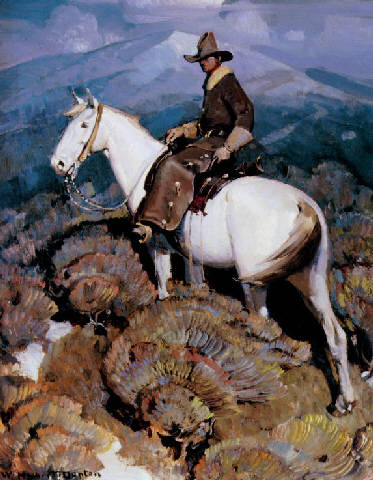
William Herbert Dunton was a famous artist known for his realistic depictions of cowboys and other characters from the American West. Dunton was born in Maine and worked as a ranch hand during his youth for small cattle businesses in the New England states of Maine and New York.
Dunton moved to Taos, New Mexico in 1912 and joined a colony of artists where he later established the famous Taos Society of Artists. Dunton made a career out of creating numerous artworks portraying the American West. One of his most well-known paintings is titled The Horse Rustler.
Also Read: Famous Horse Panitings
This work features a lone cowboy mounted on a white horse with a mountainous background that very closely resembles Taos and the northern New Mexico landscape.
The horse and cowboy’s appearance and subtle colors are what critics point to as the reason why this work is one of the more iconic of the American West paintings.
5. A Dash for the Timber – Frederic Remington
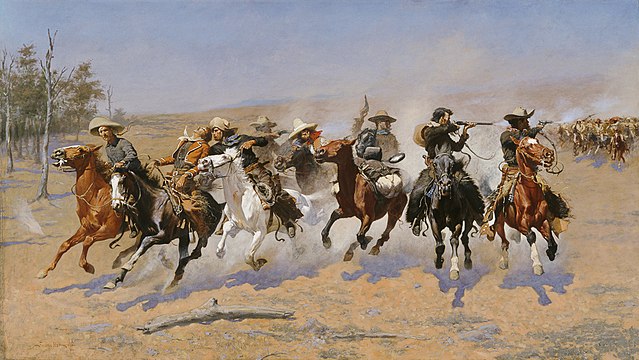
Remington was one of the more adventurous artists that created depictions of real-life events which were told to him by individuals directly involved with certain skirmishes with Native American war parties.
During a stretch of time when he ventured into the Southwest to document the events of the Apache Wars, Remington was inspired to create a painting that would later be viewed as one of his greatest masterpieces.
Also Read: Western Artists
The painting was titled A Dash for the Timber and Remington completed it in 1889 shortly before returning back from his venture into the southwestern portion of America.
The painting portrays a frantic group of cowboys that are being pursued by what appears to be Apache warriors, who had an especially terrifying reputation.
This painting is one of the more cinematic works that depicts the cowboys firing their pistols and rifles as they flee into the cover of the timber to make a stand and fight against the Apache warriors.
6. The Herd Quitter – Charles Marion Russell
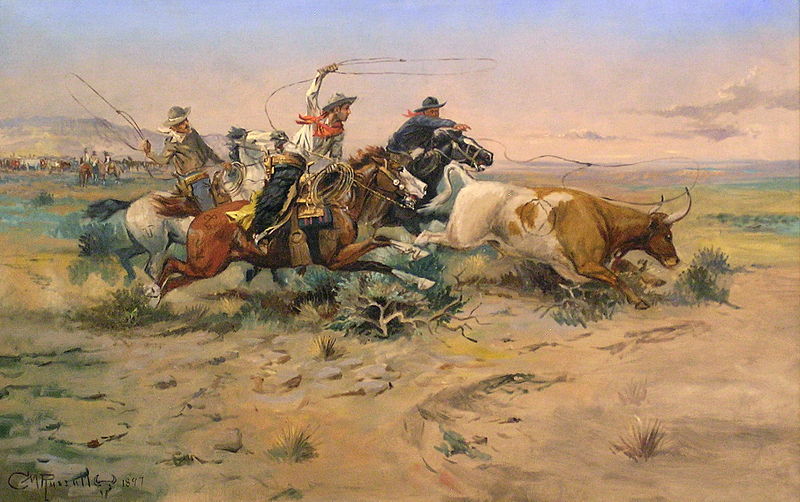
Many of Charles Marion Russell’s works depicted some of the obstacles that cowboys commonly faced in their work as ranch hands or in other endeavors.
Trying to maintain a large herd of cattle was often a very difficult task that required considerable concentration and quick acting on behalf of the cowboy to maintain as many of the herd as possible on the way to their destination.
Also Read: Famous Cow Paintings
Another one of Russell’s most famous works features a scene which portrays a group of cowboys pursuing a single cow that’s running away from the herd.
The term ‘herd quitter’ was often used to describe cattle that broke away from the main herd and showed no desire to return, which often forced cowboys to run them down. The painting is just that and depicts three dusty cowboys riding hard after a cow as they pitch their lassos toward it.
7. When Spring Comes to the Cattle Country – H W Hansen
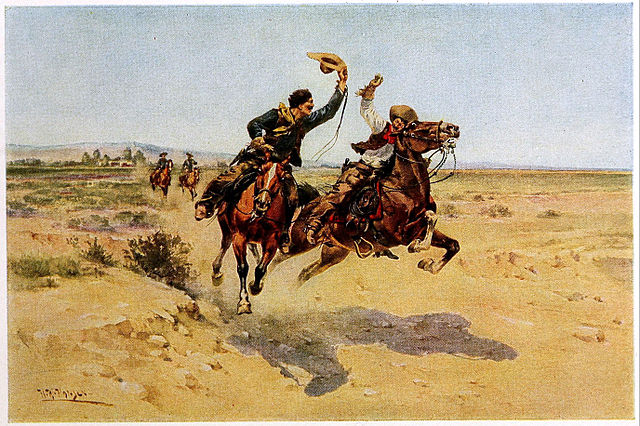
Herman Wendelborg Hansen was a German-born painter who would become one of the most notable American West painters of the late 19th and early 20th centuries. He showed considerable interest in the American West in his youth and moved to New York in 1877 to work as a commercial illustrator before later moving to Chicago to study art.
Hansen traveled the West throughout his 20’s and 30’s and soaked up much of the cowboy lifestyle and many of the things that set cowboys apart from anyone else in America at this time. One of his paintings is regarded as his greatest work and is another iconic cowboy painting from history.
The painting is titled When Spring Comes to the Cattle Country and depicts a group of cowboys riding across the open plains. Spring often was the time when ranchers sent their cattle to be sold and cowboys viewed the onset of the spring season as a time when they could once again take to the trail and live the lifestyle they loved.
8. Aiding a Comrade – Frederic Remington
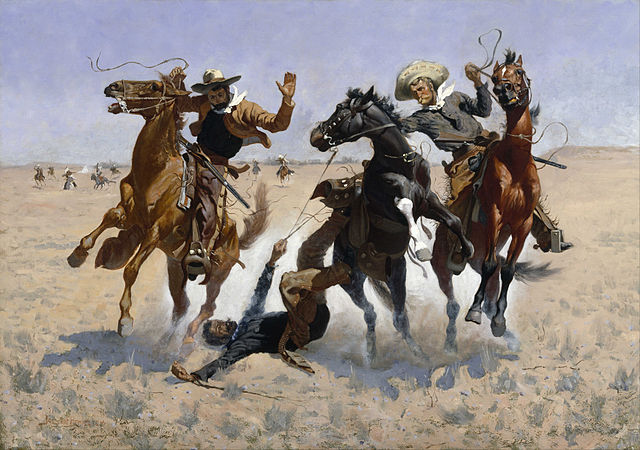
The life and work of a cowboy was filled with danger and risk. Many times, cowboys were thrown from their mounts and trampled underfoot from the very herd they were driving while other times they might be pursued by cattle rustlers or deadly Native American war parties.
Frederic Remington often painted scenes that portrayed the more dangerous encounters the cowboys had to endure.
In 1880, Remington completed a painting that depicts cowboys rushing to the aid of one of their own who had fallen from the saddle, but his foot is apparently caught in the stirrup.
This would often be a deadly ordeal, or one in which the cowboy would be severely injured unless the horse was stopped. Remington’s use of intricate detail and incredibly realistic colors make this scene appear to be right out of a western novel or cinematic feature.
9. Smoke of a .45 – Charles Marion Russell
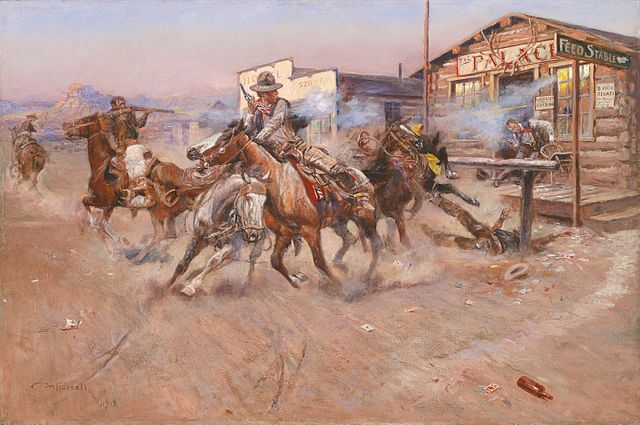
Charles Marion Russell was one of the few artists who focused much of his effort on portraying the more gritty parts of life as a cowboy in the American West. One of his paintings is among the most well-known among collectors and those who are well-acquainted with artwork of the American West.
The painting is titled Smoke of a .45 and was completed in 1908 when there was considerable public interest in the ‘old days’ where gunfights were a common happening in the Wild West.
In this painting, a group of cowboys are engaged in a gunfight, but it’s difficult to tell which side is justified in using deadly force against the other. The scene is action-packed with the horses scrambling to flee while the men fire off shots at one another in front of a dusty old saloon.
10. Cowboys Roping a Bear – James Walker
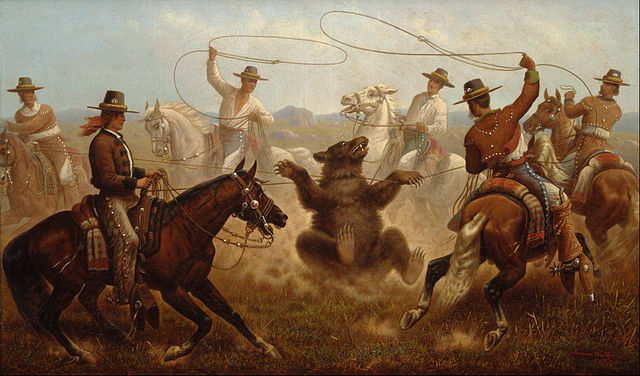
James Walker was one of the earlier artists who is remembered for his paintings of the American West. He was born in Britain, but spent many years painting scenes from the American West and the various exploits of cowboys. Few of his works are as prominent as one that he completed around 1877 titled Cowboys Roping a Bear.
This painting depicts a group of 6 cowboys riding and encircling a bear as they lasso it with their ropes. Bears were often caught in this manner and used in circus shows or other attractions throughout the American West and some critics believe this scene is capturing the moment one of these ‘kings of the forest’ is captured on the open plains.
The painting likely represents the effects of mankind on nature and how the settling of the American West was, in some ways, detrimental to the wildlife and nature in the region.

